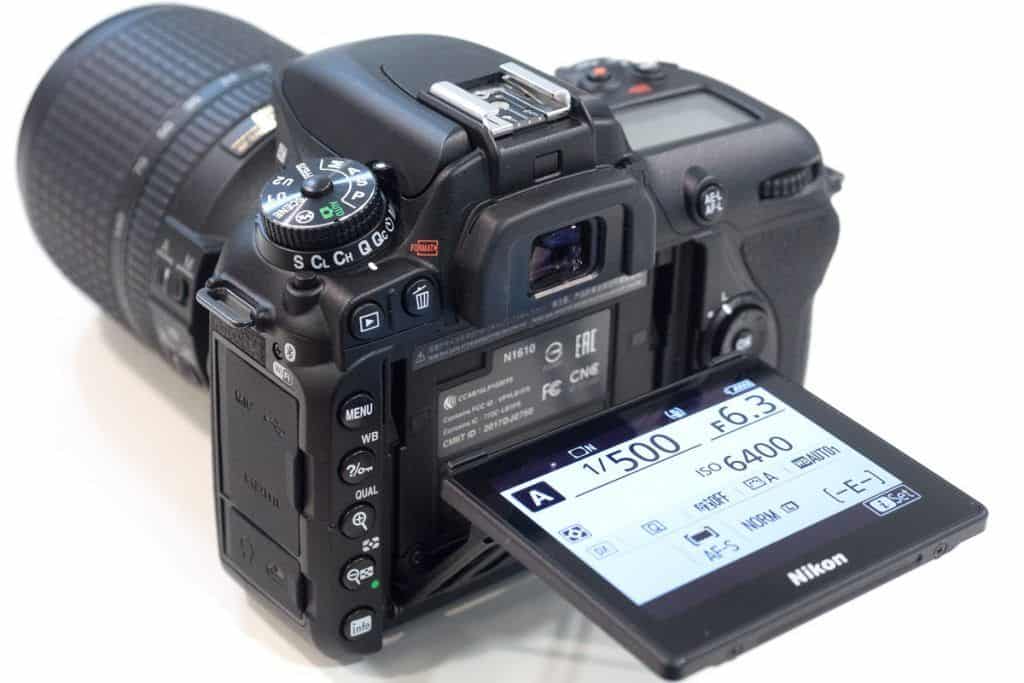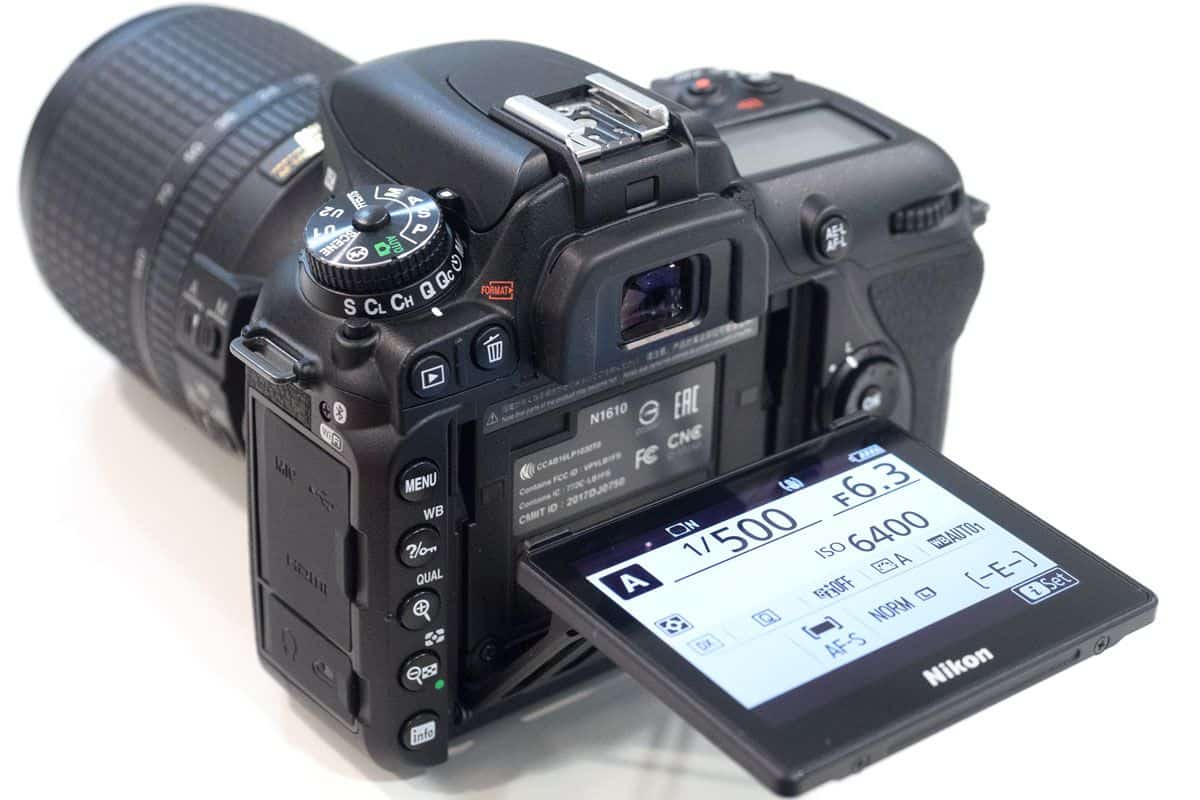Table of Contents
amazon Nikon D7500 reviews
Pros of the D7500:
8 frames per second
3D AF tracking works very well
50-shot RAW buffer
Anti-dust and weather-sealed
4K video
Cons:
Lacks certain advanced features present in the D7200
4K video a possible subject of interruptions
Technical definition of the Nikon D7500
Model name full: Nikon D7500
Resolution: 20.90 Megapixels
Size of Sensor: APS-C, 23.5mm x 15.7mm
Kit: N / A
Viewfinder Type: Optical / LCD
ISO is 100 – 51.200
ISO Expandable: 50 – 1.640.000
Shutter: 1/8000 – 30 seconds
Body measures: 5.3 by 4.1 by 2.9 inches (136 x 104 x 73 mm)
Body weight: 25.4 ounces (720 g)
Main Features of the Nikon D7500
20.9-megapixel CMOS image sensor
Normal ISO range 100-51,200 with an extendable limit of 50-1,640,000
EXPEED 5 processor
Continuous shooting up to 8 fps
Automatic image control
4K UHD recording at 30p
Wi-Fi and Bluetooth built-in
SnapBridge capability
where can you get a Nikon D7500 online
Nikon D7500 DX-format Digital SLR Body: Buy it now
Nikon D7500 DX-format Digital SLR w/ 18-140mm VR lens: Buy it now
Nikon D7500 Black Digital SLR Camera with 18-140mm VR & 70-300mm f/4-5.6 SLD DG Macro Telephoto Lens + Accessory Bundle: Buy it now
Nikon D7500 20.9MP DSLR Camera with AF-S DX NIKKOR 16-80mm f/2.8-4E ED VR Lens, Black: Buy it now
Nikon D7500 20.9MP DSLR Camera with AF-S DX NIKKOR 18-300mm f/3.5-6.3G ED VR Lens, Black: Buy it now
Processor
The very pronounced difference in the handgrip is now felt in the D7500, which has almost a feeling of latex in the rubber coating and certainly gives more contact area to grip the body between the lens and the clamp for a much easier grip. The rear rubberized thumb grip has just the right touch to hold on to, but not too aggressive when compared to some competitor’s cameras.
The ‘i’ button located on the rear panel allows quick access to most functions of the camera. A crystal-clear color and text are presented on the LCD monitor, which measures 3.2 inches and has a metal hinge for extra strength and was quickly flipped out when operation was needed. The monitored view extends vertically up and down, providing pleasing angles for photo shooting and excellent angles for video shooting. The touch sensitivity works like a charm, making things like changing the settings in a jiffy and scrolling the display menus and changing settings.
D7500 is blessed with 51 focusing points, with enough area to cover a good variety from left to right and not entirely unreasonably vertical. Focus points can be selected from the live view display anywhere on screen using the 4-way controller as well as the touch screen area. Optical viewfinder in the D7500 is reasonably nice to use with thin sizing and built to track the eye and offer motion compensation. The electronic level can be displayed in the optical viewfinder by pressing the Fn1 button on the front panel (by default).
Menu
Menus will be familiar to anyone who has used a Nikon digital SLR camera. Cabinet are further divided into options of Playback, Capture, Movie, Custom settings, Menu settings, retouch, and mymenu. There is a help guide also. If you don’t wish to be cranky while working with the camera, you can really put your thinking cap and custom-make the “MyMenu” into an interface with your favorite options and settings.
Wi-Fi features
Bluetooth is used for initial setting of connection via SnapBridge by Nikon. You’ll have a choice of transferring either 2mp photos or full resolution ones; with full resolution it could be painfully slow. To remotely operate your camera, you’ll then have to connect to it over Wi-Fi. This worked great on Android. There are few options, really; it acts mostly as a remote shutter and AF point selection is possible.
In Bluetooth settings, send in off can be selected with the D7500. While the camera is switched off, the images were still sent to the smartphone. This may considerably drain the battery.
Battery life
Test results show CIPA/Nikon battery life numbering 950 puts the D7500 in a more favorable light concerning battery life, thus encouraging better photography. The use of Wi-Fi and Bluetooth also adversely affects battery life.
User Experience
Ease of Use
The Nikon D7500 sports a user-friendly interface, an organized menu system, customizable controls, an intuitive touchscreen LCD, and physical buttons, all allowing a comfortable flow of settings adjustment. The camera body and ergonomics feel good, making it just as suitable for amateurs as it is for intermediate users.
Field Performance
The D7500 is a great performer in various shooting environments. The autofocus system, high-speed continuous drive, and video capabilities enhance the camera’s multi-purpose use for varying photography genres. Considering image quality and dynamic range, this camera copes well with shooting diverse subjects under many lighting conditions.
Learning Curve
The D7500 is simple to learn if one is experienced with DSLRs or advanced point-and-shoot cameras. It’s easy to get to myriad controls and settings on the camera, and a comprehensive user manual gives one a good grasp of the camera’s features and how to apply them. The tilt-adjustable LCD and touchscreen help put all features in the user’s hands more conveniently, allowing them to adjust faster to the controls and features of the camera.
Other Cameras in Comparison
Nikon D5600
The Nikon D5600 is aimed at entry-level users and shares a few things in common with the D7500, which include a 24.2-megapixel sensor and built-in Wi-Fi. Really, though, the D7500 shows off some added features like a greater continuous shooting speed, an advanced autofocus system, and 4K video recording. Whereas casual shooters might be able to use the Nikon D5600 fine, photographers who would otherwise be serious enthusiasts or semi-professionals would use the D7500.
Canon EOS 80D
The Canon EOS 80D is an out-and-out competitor to the Nikon D7500 with similar features, including a 24.2-megapixel sensor and a vari-angle touchscreen apparatus. The 80D’s Dual Pixel CMOS AF setup means great live view and video autofocus-an advantage especially for video, vlogging, and live-action shots. Apart from supporting Full HD video recording, the 80D, however, cannot shoot 4K video, which the D7500 does. The 80D features a 45-point all cross-type autofocus system, granting high performance for still photography but one that is a little below the 51-point system in the D7500.
Sony Alpha A6300
The Sony Alpha A6300 mirrors the Nikon D7500 alternative. It offers a few more options, with its 24.2-megapixel APS-C sensor and a cutting-edge 425-point phase-detection autofocus system. It does not have full-frame format, but its features make it the highest contender in the mirrorless arena. A6300 is compact and quite light compared to D7500, which will be appealing for people looking for portability. However, ergonomics, optical viewfinder, and long battery life are on the D7500’s side when DSLRs are preferred.
Pentax K-70
Among the DSLR competition available today is the Pentax K-70, which sits in the market’s midrange. It is a 24-megapixel basic APS-C sensor in a housing that’s weather-sealed and rugged: a body in which all operations will function without letting in moisture. The K-70 offers great performance in heavy weather conditions and is good on its image stabilization, which can mean a lot for shooting without a support system. It hasn’t provided 4K video recording nor does it provide faster continuous capture than the D7500. In fact, dynamic shooting and multimedia applications benefit from the D7500’s superior autofocus system and video capabilities.
Strengths and Weaknesses
Strengths:
High-Resolution Sensor and Processor: A 20.9-megapixel sensor and the EXPEED 5 processor deliver great image quality with superbly detailed productions and highly vibrant colors with incredible dynamic range.
Advanced Autofocus System: The 51-point autofocus system, complete with Group Area AF and 3D Tracking, ensures accurate and reliable focusing for precise action and sports photography.
Video Recording in 4K UHD: The support for 4K UHD video recording in D7500 allows taking high-resolution videos with very little crop and significant benefits for video enthusiasts and professionals.
Tilt-Adjustable Touchscreen LCD: This 3.2-inch LCD features tilt-adjustable forms of functionality that give flexibility and convenience in photography.
Dual SD Card Slots: Two-card slots offer flexible storage options and backup capabilities for managing large volumes of data.
Durable Build and Weather-Sealing: The magnesium alloy with weather-sealing provides durability and ruggedness over extreme shooting conditions.
Weaknesses:
Very Limited Frame Rates for 4K Video: This is the case for 30 frames per second in 4K UHD where the D7500 offers recording because not all applications involving video editing can work with frame rates lower than this for specific purposes.
No In-Built Image Stabilization: The D7500 totally ignored the in-body image stabilization. Thus, stabilized lenses should be used with the camera or external stabilization methods for handheld shooting, especially in low light.
Battery Life: The life of the battery is free, but most users doing extensive shooting or videotaping find the need to carry extra batteries, especially for long shoots.
Dimension and Weight: The D7500 is bulky and heavy for a DSLR but compact and really light compared to mirrorless competitors. It may create concern on portability for some users.
Complicated Menu System: The large array of features and options for customizing the camera make the menu system very complicated, and that can be overwhelming to new users.
Conclusion
The Nikon D7500 is a high-performing multi-functional DSLR camera that’s mid-range. It is with the latest sensor and image processor, a powerful autofocus system, and the capability to shoot high definition video. This opens the door for enthusiastic amateurs and semi-pros to further their craft. Building quality, weather-sealing, and customizable controls contribute to usability across much of the shooting environment.
The D7500 makes a good all-round camera, albeit with the inbuilt image stabilization, and navigation of a somewhat difficult menu system, for users in search of a well-balanced portrayal of image quality, performance, and durability. With its value, it stands clear among other comparable mid-range DSLRs and mirrorless cameras as an option for those who prefer the feel and functionality of a conventional DSLR with an optical viewfinder.
Very good indeed, in terms of shooting stills and recording videos, this camera stands out among others. This blend of features, an easy-to-use framework, and high performance definitely put him in a good place on the podium with other competitors in his category. The D7500 reliably delivers high results in all aspects, making it a very valuable gadget for a wide variety of photo and video uses-from action shots to landscapes to videos.

